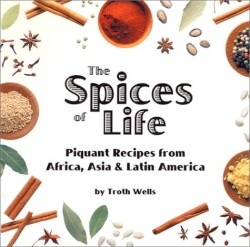The Spices of Life
Piquant Recipes from Africa Asia & Latin America
Muhammad, Jesus, and various Popes and bankers like the Medicis and Fuggers have walk-on parts in this story where torture and blood-and-guts violence arise from prophets and religion as much as from profits and capitalism.
This story is not the stuff of most cookbooks: the author transcends the usual ethnic fare with this brief, but accurate, history of the spice trade from the Egyptians and Sumerians to the present. She also delves into its many ramifications. Along the way she gives readers insights into the relevant backgrounds, usually economic, of the countries she visits. The over 100 recipes are authentic, requiring local ingredients and even regional cooking methods such as a stone fire to produce Groundnut/Peanut Stew with Fish, a dish from Sierra Leone. Readers wanting to try the recipes should have access to specialty markets or online sources.
Having worked with the British magazine New International for nearly 30 years, Wells is well traveled in Central America, Africa, and South-East Asia. The Spices of Life is her second cookbook on these areas and her most comprehensive. Her prose is honest and clear, and the content she chooses to include is full of specifics, both positive and negative. For instance, while she notes that a UK consumer magazine calls Bangkok and Pattaya “the sleaziest holiday spots in the world,” she also mentions the lovely countryside, ancient temples, and of course, the excellent food, and includes the recipe for fragrant Rice and Coconut Pudding.
This book is rare in its breadth and careful detail, and the target audience is not simply the cook looking for new recipes. Wells writes for the spice lover, the student of ethnic cooking who wishes to explore less studied cuisines, and even the sociologist examining relationships among cultures, their foods, their spice trades, and the forces that act upon them all.
The color photographs-of regional vendors, native cooks, farmers or children working in the fields-are artfully composed and intelligent in subject choice. Mostly by Amedeo Vergani, with many by Wells, they are visual essays in themselves. With the folk art on each double-page spread, this cookbook might also be studied as art.
Disclosure: This article is not an endorsement, but a review. The publisher of this book provided free copies of the book to have their book reviewed by a professional reviewer. No fee was paid by the publisher for this review. Foreword Reviews only recommends books that we love. Foreword Magazine, Inc. is disclosing this in accordance with the Federal Trade Commission’s 16 CFR, Part 255.

